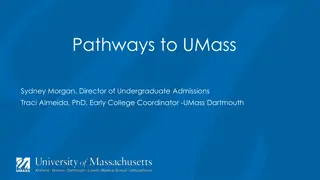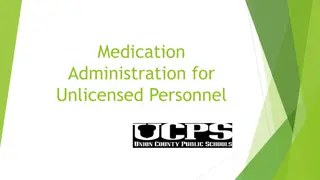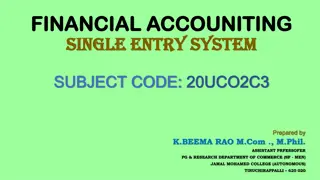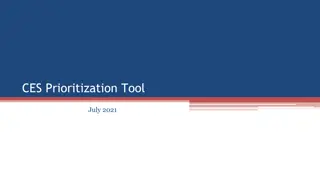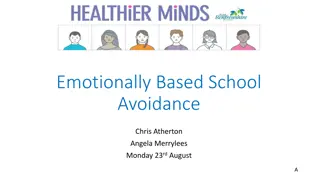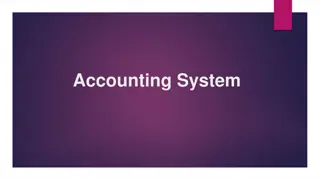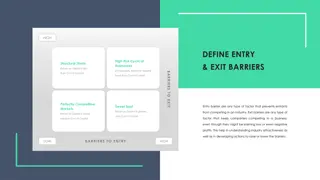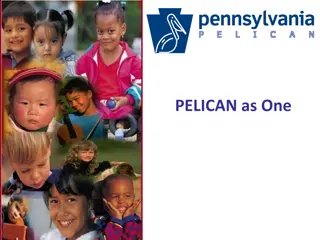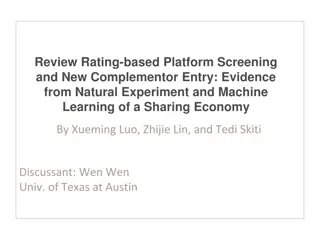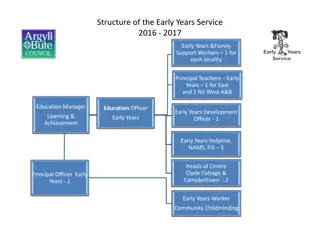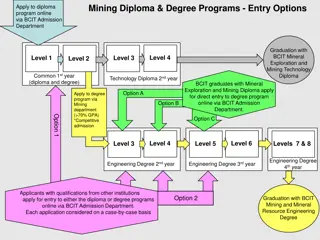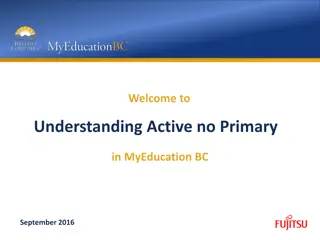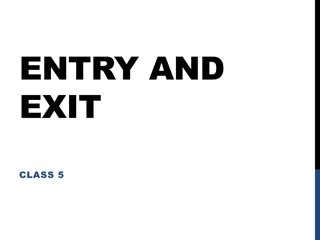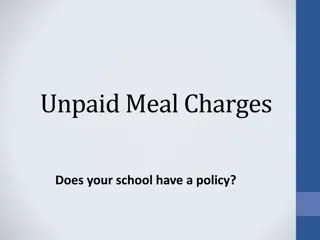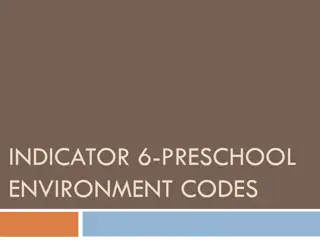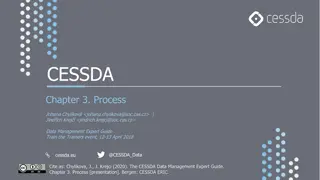Early Entry Policies in Primary School Programs
It is essential to understand the guidelines for early entry in primary school programs to ensure appropriate access to educational opportunities for younger students. The process of screening should focus on developmental readiness rather than expecting advanced skills. Admission criteria should not unfairly disadvantage students based on arbitrary age cutoffs.
Download Presentation

Please find below an Image/Link to download the presentation.
The content on the website is provided AS IS for your information and personal use only. It may not be sold, licensed, or shared on other websites without obtaining consent from the author.If you encounter any issues during the download, it is possible that the publisher has removed the file from their server.
You are allowed to download the files provided on this website for personal or commercial use, subject to the condition that they are used lawfully. All files are the property of their respective owners.
The content on the website is provided AS IS for your information and personal use only. It may not be sold, licensed, or shared on other websites without obtaining consent from the author.
E N D
Presentation Transcript
o Entry Age Requirements o Early Entry Policies o Brigance Screening Ready with Enrichments o CIITS Initiatives o KY Core Academic Standards/Curriculum Mapping o KY System of Interventions (KSI)/RTI o Changes in Restraint/Seclusion Regulations o KPREP Testing Analysis and Instructional Generalizations o District Empowerment/Charter Initiatives o PGES Teacher and Principal
Learns Learns Rapidly Rapidly ASKS REASONS WHY ASKS REASONS WHY QUESTIONS ALMOST EVERYTHING QUESTIONS ALMOST EVERYTHING
KRS 158.030 states that "[a]ny child who is five (5) years of age, or who may become five (5) years of age by October 1, may enter a primary school program, as defined in KRS 158.031, and may advance through the primary program without regard to age in accordance with KRS 158.031(6)." KRS 158.031(1) states that students must complete the primary school program (from beginning of enrollment in school through the end of third grade) before they may enter fourth grade. However,KRS 158.031(6) states that "A school district may advance a student through the primary program when it is determined that it is in the best educational interest of the student. A student who is at least five (5) years of age, but less than six (6) years of age, and is advanced in the primary program may be classified as other than a kindergarten student if the student is determined to have acquired the academic and social skills taught in kindergarten as determined by local board policy in accordance with the process established by Kentucky Board of Education administrative regulation."
It is logical to infer that by providing an option for younger students to opt-in to early entry it was not the intention of the new law to further limit appropriate access to instructional opportunities for students once they are in. If the students are attending, the ADA for those students must follow, regardless of age. Just as kindergarten students who are accelerated may be classified as P2 (1st grade students) for purposes of ADA, early entry students must be classified as kindergarten students for ADA. Failure to do so will guarantee that NO district will be in a position to enroll early entry students.
As the screening process is developed, it is imperative to consider that we should not be expecting early entry students to perform YEARS ahead of their peers. Entry cutoff dates are arbitrary and it is inappropriate to expect that students must already read fluently, compute fluently, write well, and be leagues more mature than their peers just to gain entry to a kindergarten classroom where (in most cases) they will be expected to spend the year learning to identify sounds and letters, some basic sight words, count and write letters, and participate in exploratory and socializing activities. In most cases, parents might appeal for admission for a child who is days or weeks from the cutoff, making it artificially limiting to expect that the student be years beyond their peers just t gain access.
FreeAccess to early entry should not perpetuate the myth that gifted equates with privilege Well-publicized should not be a well-kept secret Easy to get to limit barriers to the decision- making process so parents with limited resources may effectively advocate for their child
Students who demonstrate readiness early will learn habits of underachievement that may haunt them for a lifetime. We need to develop policies and regulations that remove rather than create, barriers to quality education in Kentucky. remove,
1. Decisions around early entry must be based on multiple sources of data, with careful attention to parent input, and with emphasis on inclusion, rather than exclusion. Parents of young children have seen them perform and react in a range of settings that can inform predictions about school performance. Use parent survey data that will give background about task persistence, interests, learning styles, social interactions, etc. (Brigance parent rating form could be a part of this process). Checklists regarding G/T preschool behaviors should also be helpful. 2. Require/authorize early administration of Brigance to those seeking early entry (before school starts) and expect a performance of >80.00 on an "off-level" test. For example, the 4 year old student would be screened on the 5 year old screener (or even the K-1 screener). That would give a measurable indicator of the student readiness to thrive in the school environment and could give information regarding instructional strengths/needs. This would be cost effective as it is a test that is already going into place and would not establish an unrealistic bar. The goal of this early admission process is not to identify students as gifted at this age. It is to determine whether the student demonstrates a readiness that would be well-served by including them into a primary program.
3. Inform districts/administrators/teachers about the characteristics of gifted students beyond their ability to read or write early. By focusing on only screener data, we will be only finding those students who can already do what kindergarten is going to teach them. It is important to include elements in the search that allow us to also find students with a broader ability base. As we look at some of the indicators as characteristics of gifted children (ie. is very sensitive, is concerned about fairness and justice, is highly creative, tends to question authority), it is important to note that these may read as "immature" to an unaware adult. It is important to understand that for those qualities--increased age will not minimize the impact. That child/adult may always cry easily or balk when a rule or action is perceived as illogical or unjust. A quality classroom in which the student is able to put those characteristics into the context of group and individual activities and concerns will be imperative to establishing a positive focus. BEWARE OF CHARACTERIZATIONS THAT JUST CLASSIFY THE STUDENT AS IMMATURE.
Policy in place? Procedures in place? How is it publicized? How is equitable access assured? How is focus on readiness rather than calendar maintained? What can be done to improve access to school for young students?
Barriers to Continuous Progress: Failure to use evidence of prior mastery to modify instruction Possible Outcomes Promotion of Habits of Underachievement; Loss of Motivation Barriers to Continuous Progress: Possible Outcomes
Alternatives Emphasize clearly defined mastery criteria; use pre- assessment and diagnostic instruction based on performance data; Assure instructional density build maps around multiple standards with open- ended products & processes that will promote differentiation Alternatives Practice/Trend Emphasis on common content, process, lesson to reflect standard coverage /mastery. Barriers to Progress Limits/penalizes differentiation and focuses teacher planning/instruction on middle levels. Limits/penalizes differentiation and focuses teacher planning/instruction on middle levels. Emphasis on mapping processes that dictate universal pacing everyone in the same place at the same time. Development of single assessments/common products to reflect standard mastery. Limits/penalizes differentiation and focuses teacher planning/instruction on middle levels. Develop range of products /student performances to reflect standard mastery at high levels.
Each component has anchor standards and/or practices that are intended to be the basis for CCR; By approaching those at a global planning level, many quality activities can be used to practice and refine skills Beware of focus on deconstructed pieces that do not allow for broad applications and deeper understandings: Beware of common planning and assessments that fail to acknowledge what students can already do. CCSS Math. Practice MP1 Make sense of problems and persevere in solving them. Literacy/Reading Anchor 1 Read closely to determine what the text says explicitly and to make logical inferences from it; cite specific textual evidence when writing or speaking to support conclusions drawn from the text.
Choose activities, products, and performances that support progress through multiple standards with opportunity to extend UPWARD. Determine the theme of a story, drama, or poem from details in the text, including how characters in a story react to challenges or how the speaker in a poem reflect on a topic; summarize a text.
Link with listening/speaking standards Link with writing standards Link with standards building skills with comparisons, analysis of point of view, author choices, etc. Link with informational reading standards Link with relevant content standards historical fiction, content poetry, key vocabulary
KY System of Interventions (KSI)/RTI KY System of Interventions (KSI)/RTI Talent Pool/High Potential/GT Students Needs May Represent both Deficits and Strengths to be Addressed RTI Addresses the Academic and Behavior Needs of All Students! Universal screeners and ongoing monitoring are expected to establish baselines and to get true pictures of student performance. Levels of intervention are matched to student needs as progress is monitored. Establishing a strength profile provides invaluable information to guide planning and instruction. Due to asynchronous development of G/T students, Tier I and Tier II interventions will be necessary to address both strengths and deficits.
RTI is a school improvement model!! Potential for better instruction for ALL, including Gifted students. Requires improved teacher capacity to address students as individuals. Requires building capacity to use data effectively to diagnose strengths/needs and to measure effectiveness of interventions. Requires MORE than the adoption of a program or system . Breaking down the barriers posed by everyone on the same page instruction benefits GT students, too. As long as the measures used to gather the data have no ceiling, measuring progress for ALL is a reality. The range of needs of students, both academically and behaviorally, requires improved teacher capacity and use of multiple forms of intervention!
Focus on remediation/Focus on deficits Focus on continuous progress for all, including students demonstrating mastery; focus on strengths Choose assessments and models with high ceilings to reflect student performance ranges Build interventions on standards continuum Low ceilings on screeners, assessments, and product models Focus on enrichment rather than meaningful progress Barriers: Alternatives:
CIITS is a multi-phase, multi-year project designed to provide resources Teacher access to Kentucky academic standards and directly linked, aligned, high resources in learning and reinforce the standards being taught. Formative assessments creation on particular standards with the help of a test item bank containing more than 11,000 items; Can identify learning gaps exist so that they can more easily design instructional experiences to meet individual student needs and adjust their instruction in support of learning the hallmarks of formative assessment. Aggregate and student-level demographic, program and performance information to gauge student progress toward Kentucky s goal of every student being proficient Teacher access to Kentucky academic standards and directly linked, aligned, high- -quality, multi resources designed to engage students Could be used for pre- assessments? Key will be teacher response to the data! Establishes proficient as the statewide goal. Limited benefits for primary students? quality, multi- -media instructional media instructional Formative assessments creation based program and performance information to gauge student progress toward Kentucky s goal of every student being proficient.
Opportunity for sharing of resources; potential for true big picture curriculum and instruction development; Oversight for quality control??? Be vigilant about the inclusion/awareness of GT needs in each facet of CIITS resource development Lesson planning tool and scheduler to help teachers manage standards instruction in their classrooms. also share instructional resources they design through CIITS. Interim assessment data K K- -Prep, ACT, and other data will be uploaded into the system. PD 360 targeted professional development, resources, and follow-up Lesson planning tool and scheduler to help teachers manage standards- -based instruction in their classrooms. Teachers may based Opportunity to increase access to meaningful professional development matched to teacher needs; Instructional Differentiation resources ARE available at the beginning level; Imperative to build differentiation from STANDARDS rather than activities!!! GT needs must be considered within each indicator!! Interim assessment data Prep, ACT, and other test
Focus on deficits/search for quick fixes Lack/loss of meaningful writing instruction across the curriculum Balance analysis with focus on strengths and needs; acknowledge that meaningful progress requires sustained commitment to quality instruction Increase emphasis on writing process and practice with writing standards at high levels Maintain adequate instructional attention on students already demonstrating mastery Monitor progress at school level to credit growth (minimally 1 month growth of 1 month instruction, no matter where they start) Low payoff for high performing students Statistical difficulty of measuring adequate growth when students are already at high levels
Early Entry/Early Exit earning college credit in high school Seat time requirements reduced in favor of demonstrations of mastery; increased student ownership in success Traditional and direct instruction interpreted as sameness Assure quality of offerings AP/IB have universal transferability; not true of all dual credit Develop supports for students who may lack executive function skills Support balance of orderly learning community and differentiated instruction Assure equal access to quality programming for ALL
Temper implementation of new initiatives to minimize the potential barriers progress of high ability students. Build teacher and parent understanding of causes and impact of underachievement; build capacity in changing habits Build teacher and parent awareness of characteristics of gifted students and the impact of those characteristics on instructional planning and delivery Work to help build capacity of all as they work to increase differentiation opportunities that promote continuous progress


